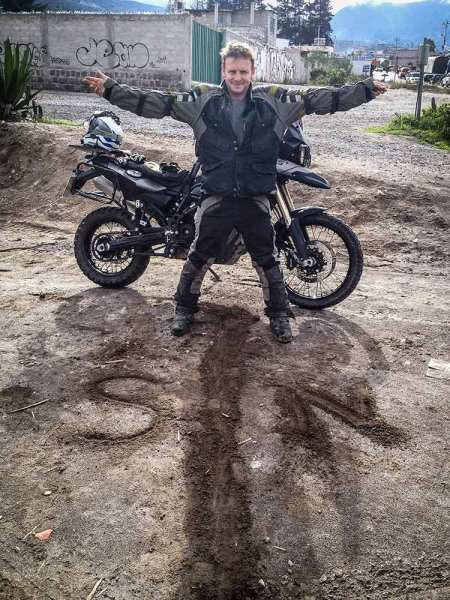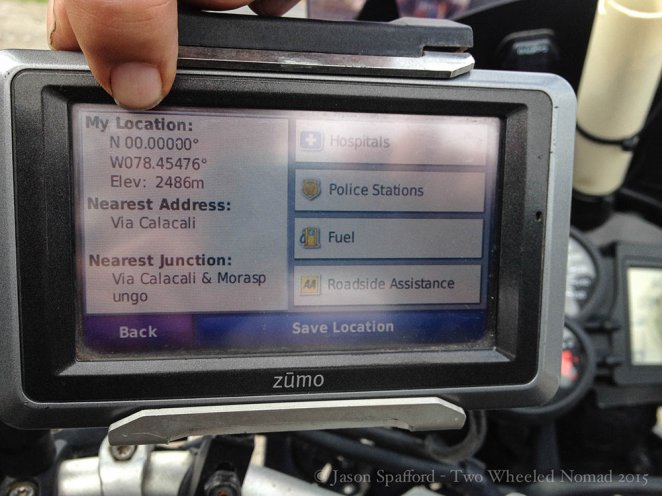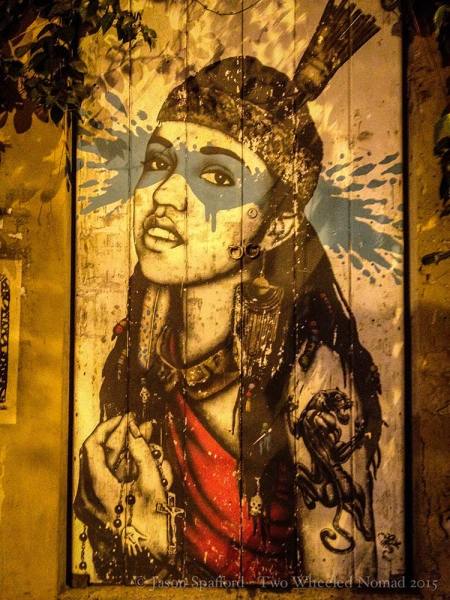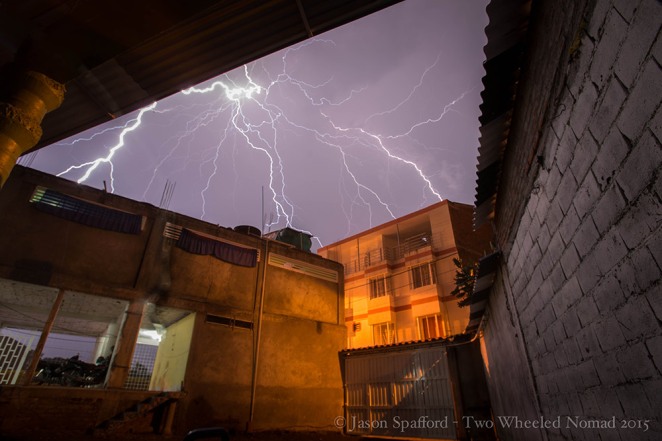Reluctantly extricating ourselves from the Ecuadorian jungle, we found ourselves in a non-lulling state of head-loll as the bus buckarooed its way back to the concrete jungle, Quito. Seated near to a pair of young males, I overheard a similarly aged girl sat adjacent pipe up: “Sorry, I’ve got to ask: why’ve you got a broom with you?”

Whoa! You can be in two places at once: the southern & northern hemispheres on some waste ground, Quito’s true equator.
“Oh ya, this is so fun-ny” in between hyena-like laughter, as though caught out by his own hilarity, “I’ve literally just bought it so that my friend Will, here, will have to carry it around where ever he goes. Crazy I know but not as crazy as Will. Ya, Will bought a parrot and gave it to his friend Mark at the start of his round the world tour. He’s had to carry it around with him the whole time, and get this: smuggle it across borders by putting it in the fridge on the back of buses! I know, hil-ari-ous!” The girl burst into a fit of uncontrollable giggles. I turned the volume up on my David Attenborough audio book—being back astride Pearl couldn’t come quick enough.

The unofficial true equator on some waste ground near Quito’s officially false Equatorial Monument
As cyclones in Colombia, due primarily to the last ferry crossing the Darien Gap to Panama ending for the foreseeable, we had to roar up the road like conquistadors. And faced only four scanty weeks in which to do so. Entering Colombia all guns blazing—stiflingly hot—the first thing we encountered was guns and riders. So many of each but one whose nose was poised pointing down, while the other was razz-tazzing around like a sniffer dog. Thumbs up from virtually every armed soldier was the order of the day—a reassuring state of civil rest, where security remains an issue on occasion in the southern portion of the country. So far, so calm.

The coffee bobbled landscape of Colombia
That is, until I was rudely bumped by a local on his 125cc, flinging me forward haphazardly in a drunkard fashion up a hill. Easy chap. Keep your eyes ahead, would you, dear? No matter, my thoughts were elsewhere: the heavy presence of the military didn’t stop me pondering if we were already wandering on ground unwelcome. Good work either way fellas (although fellas might be stretching it; most hadn’t yet broken into that deeper octave range), and gracias for watching our backs against any unsavoury acts from guerrillas or armed bandits.
Go figure: Colombia’s reputation isn’t exactly speculative. Neil Bennion in his book Dancing Feat neatly summarised—and I barely summarise his words—that it started with one of those long, drawn-out internal conflicts back in the mid-60s, with its root in La Violencia—a period known as The Violence in the 1940s. The death toll over fifteen years reached an estimated 300,000, came to an end around 1958. What started as brutal, politically aggravated vengeance became the norm until Colombia was drowning in its own blood. An agreement was eventually struck between two political parties but the shadow of that era still looms, not least in the form of armed groups that emerged thereafter.

Bennion continues to explain that it’s not just the FARCs (Revolutionary Armed Forces of Colombia) that seem to elicit all the media’s attention, they’re just one of many militants across three main divisions: “left-wing groups (known as guerrillas), right-wing groups (known as paramilitaries) and government forces. Together they’ve been involved in a special citizen-twatting competition, with the first two also showing a predilection for terrorism, kidnapping and drug trafficking. And whilst in recent times the guerrillas have very much been pushed back to the margins of the country, all the entities are still very much alive and present in the belly of Colombia.” Days after riding out of the coffee zone that is Cali and its neighbouring areas, it was reported that a FARC group had shot ten soldiers there. Good grief. I’d heard of a Colombian guy recently commenting “After 200 years we’re still uncivilised. We haven’t learnt to value our freedom and all that we’ve been given.”
Thanks to Lady Luck, we only fell victim to a phenomenon that troubles various South American countries—arroyos—street rivers. Part way up Colombia, we rode into a town treading water in a torrent of rain having sought out shelter for the night: a love hotel in Tuluá moments before. Eyeball-sized rivulets of rain streaming down aside, what the pair of us couldn’t stop staring at all evening was the main attraction, right above our heads.
Lightning bounced around inside the purple belly of a bank of dark clouds as thunder billowed deeply in our ears. Talk about electric. Loving the love hotel—the entire bathroom was on display in the corner of an open plan bedroom—there goes any mystery in one’s relationship. Still, such gaudy establishments always offer a perfect place for not only couples eager to consummate their premarital relationship, folks having a fling and needing a little discretion but foremost, motorcycle overlanders in daily requirement of secure parking. Boom! Forget third base, that’s a home run.

A mighty fine electric lightning storm above our heads in Tuluá
Although Colombia’s reputation is far from remedied, the country is undergoing some serious amelioration. For the first time in a long time, tourist revenue has overtaken the income generated from coffee export. What’s more, the drug cartels were largely disbanded in the late ‘90s. Even so, Bennion informs “where big efforts have had some success, in the bigger, international picture there is still an ongoing problem of the ‘balloon effect’. This is where you squeeze it in one place and it grows bigger somewhere else.”
While the khaki-clad boys had our backs on Colombian turf, we watched the backs of beefy but immobile iguanas on asphalted turf—suddenly coming into view a little faster than felt comfortable at 50 miles per hour. Magnetised to the warmth of the sun-baked road, I slammed on the brakes a flurry of times and swerved in order to avoid elongating these already lengthy reptiles. The novelty of arboreal lizards frequenting roads rather than trees soon passed—the choked carriageways comprise such a spectrum of road users—undertaking becomes a sucking-your-backside-up-through-your-heart necessity.
Munching miles, we ploughed bottom up through Colombia; impossible to miss an inordinate number of low flying vultures and the odd pair of kites overhead. As well, the prevalence of deforestation and low-lying cane toads—the former being an utter disservice to the latter. We were half way up the country and the security detail all but disappeared. It was one of those rare occasions where an absence of evidence is actually valid evidence, where lack of guns spelled a more peaceful place. I didn’t exactly need to be reminded to stay off ground uninvited—this was Colombia..!
A flying visit meant we managed to see little and less of Medellín, although listening to Lucy, our hostel owner of Grand Hostel flung us right into her past hell. Tearing up, Lucy briefly touched upon her first boyfriend’s merciless death, his life executed by guerrillas for greenbacks. She went onto relay the story of a well-known wealthy family—employing 2,000 employees in their company—whose figurehead, the father got kidnapped. The eldest son arranged a non-negotiable exchange of his father held hostage, for himself. Or no money thereafter. The kidnappers agreed, surrendered the father and took the son captive. Within the next six months after the exchange, the family, including third cousins removed all left Colombia—many to the States.
The son beforehand, had organised his own hefty and private army to enter the jungle once his family could be deemed at a safe distance, and attempt his no-guarantee-getting-out-alive rescue. There must be a God; the mission was a success—no family member was murdered nor a cent paid to the captors. Around 80 guerrillas were killed. Business operations ceased and proceeds were distributed to the family and ex-employees. This was one of a handful of happy-ish endings. People have not forgotten, nor will they ever be likely to forgive.
NB: Special thanks goes to Neil Bennion, author of Dancing Feat whose un-put-downable account of Colombia added meaningful value to my experience of the country. Top stuff!

One thought on “28 Mar-3 Apr 2015 – Cyclones in Colombia (1 of 2)”